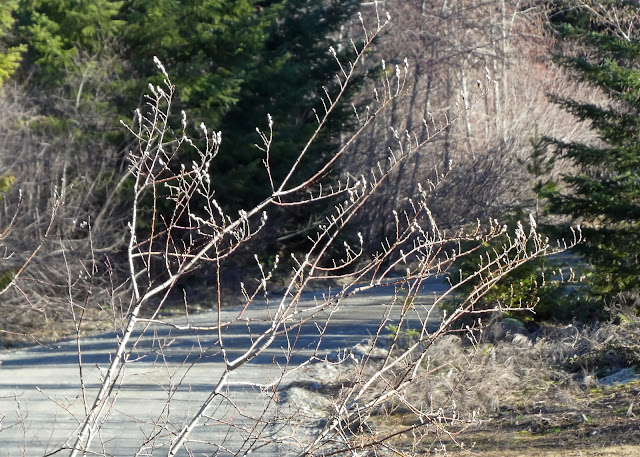It was such a beautiful day, too good to waste. Coming home from running errands, I dashed inside, grabbed the camera and headed for the hills. Too much of a hurry. I found, too late, that I'd grabbed the wrong camera, one I'd been trying to repair. Luckily, I still had the pocket camera.
When I was a kid on the far side of this island, I liked to sit outside in the stern of our little boat on trips to Tahsis so I could watch the evergreen forests slide by, so dark and secret, so alien, home to cougars and deer, not us. In some spots, high above the water, the solid bones of the mountains rose to the surface; pure rock, without even cracks for the evergreens to force open with their roots. Not bare rock, though. In this wet corner of the rain forests, the rock bore, bears still, a thick cushion of moss.
Once I climbed the hill behind our house. Through a trackless belt of hemlock and Douglas-fir, breaking at the foot of a cliff into dense salal shrubs, then, as the rock repelled even the persistent roots of the salal, the golden moss burst into sunlight. I climbed to the edge of the forest above, and sat on the moss. From there, I was alone in the world; our settlement, a few houses on the shore, was hidden. The sun warmed the moss, and me.
I didn't stay long; we kids had been warned to stay out of the bush after 5, even on long summer days; the evening and night belonged to the cougars.
Now, here on the east coast of the island, on this bright afternoon, I visited a small patch of mossy rock on a steep hillside, pocket camera in hand.
 |
| From halfway down the hill. I didn't sit on the moss this time; it was soaking wet. |
 |
| Staring into the sun. Glints off the water of Mirror Lake. The blue water is Echo Lake. The road below is a logging road. |
 |
| Nearing the bottom. Dried, winter-bare branches of Scotch broom and oceanspray bush. |
 |
| Random shot as I walked. Somehow, this "speaks" to me. |
 |
| Are those pussywillows at the bottom of the hill? I think they are! |
I didn't go down to the road beneath, this trip, because where the climb gets really steep, the moss was soggy and very slippery. Leave that to summer days.
- Vista desde la mitad de la bajada. No me senté en el musgo esta vez, pues estaba bien empapado.
- Mirando directamente hacia el sol. La luz brilla en el agua del lago Mirror (espejo). Lo azul es el lago Echo. El camino allá abajo es un camino de madereros.
- Cerca de este camino, con ramas secas de retama negra y de "espray de oceano", Holodiscus discolor. La retama negra es una planta nociva e invasiva; no me gusta ver como empieza a cubrir este sitio. Pero en invierno hace un encaje en el borde de la roca, y en verano, cuando el musgo está seco y color de café, llena el espacio de un amarillo brillante.
- Foto al azahar mientras caminaba. Por alguna razón esta vista me hace sentirme en casa.
- Sauces de gatito, o sea los botones peludos del sauce. Lo más distante que llegaba a operar la cámera; no bajé hasta el camino porque el último tramo del declive estaba muy empinado y el musgo empapado estaba resbaloso.










































